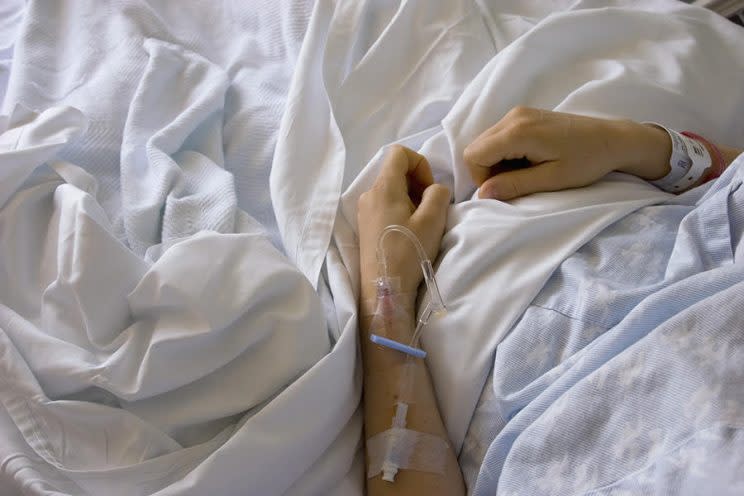Why Did This Healthy New Mother Die After Childbirth?

A heartbreaking story of a neonatal nurse who died 20 hours after giving birth has been circulating on the Internet, with many expressing outrage over her senseless death.
In 2011, Lauren Bloomstein was a 33-year-old first-time mom with a healthy, active pregnancy, according to the groundbreaking investigative story, “The Last Person You’d Expect to Die in Childbirth,” published May 12 by ProPublica and NPR. Especially comforting to the Moorestown, N.J., mom was the fact that she would give birth at the Monmouth Medical Center in Long Branch, where she worked in the neonatal department.
When she was 39 weeks and six days along, Bloomstein and her husband, Larry, headed to the hospital for her to be induced, a common procedure that kick-starts contractions. Afterward, Bloomstein began experiencing “stabbing” pain near her kidneys or liver, so doctors increased her epidural dosage, and on the evening of October 1, she gave birth to her daughter, Hailey Ann Bloomstein. In a video of the mother and daughter, published in the story, Bloomstein can be seen lovingly gazing into her daughter’s eyes.
However, Bloomstein’s pain never subsided, and hospital staff, chalking up the problem to acid reflux, a common side effect of labor, administered an antacid and painkillers.
Soon, Bloomstein’s blood pressure spiked, so the hospital ran a test for preeclampsia, a pregnancy complication marked by high blood pressure that affects up to 8 percent of pregnancies. Her results were not abnormal for the condition; however, Larry kept pushing for answers. It was only when he called his own colleague for help that he learned his wife’s condition was most likely HELLP, a severe type of preeclampsia that if not treated immediately could lead to internal bleeding and stroke.
In Bloomstein’s case, her elevated blood pressure caused bleeding in the brain, and she had decreased levels of blood platelets (cells that help the body form clots to prevent bleeding). Making matters worse, the hospital didn’t have a sufficient supply on site to use in surgery.
A few hours later, Bloomstein died.
“[E]very year in the U.S., 700 to 900 women die from pregnancy or childbirth-related causes, and some 65,000 nearly die — by many measures, the worst record in the developed world,” according to ProPublica/NPR. “American women are more than three times as likely as Canadian women to die in the maternal period [defined by the Centers for Disease Control and Prevention as the start of pregnancy to one year after delivery or termination], and six times as likely to die as Scandinavians. In every other wealthy country, and many less affluent ones, maternal mortality rates have been falling; in Great Britain, the journal Lancet recently noted, the rate has declined so dramatically that ‘a man is more likely to die while his partner is pregnant than she is.’ But in the U.S., maternal deaths increased from 2000 to 2014. In a recent analysis by the CDC Foundation, nearly 60 percent of such deaths were preventable.”
Why do so many women die as a result of pregnancy complications or childbirth?
While it’s impossible to understand the entirety of the circumstances surrounding Bloomstein’s death, according to Hal Lawrence, MD, executive vice president and chief executive officer of the American Congress of Obstetricians and Gynecologists (ACOG), there are multiple general factors. “Women are having babies later in life, and advanced age often means underlying issues with diabetes and blood pressure, for example,” he tells Yahoo Beauty. “Obesity is also an issue — more than half of women in this country have BMIs greater than 30, which can complicate a pregnancy. And IVF rates have increased, which can lead to multiple babies and more high-risk pregnancies to begin with.”
Also concerning is inadequate federal funding that goes toward maternal care versus infant care — ProPublica/NPR reports that only 6 percent of block grants in 2016 went toward programs for mothers versus 78 percent devoted to infants.
For Bloomstein, miscommunication between hospital staff members worsened her odds of survival. Despite “abnormally high” blood pressure readings, she was inadequately monitored, including an eight-hour period when she simply wasn’t monitored at all. In a deposition following her death, Bloomstein’s ob-gyn admitted that she “might have been recommended to be monitored more closely, in retrospect.”
In 2012, Larry Bloomstein filed a complaint against Monmouth Medical Center, and the New Jersey Department of Health ultimately found fault with the hospital. Among its findings: “There is no record in the medical record that the Registered Nurse notified [the ob-gyn] of the elevated blood pressures of patient prior to delivery,” and “there is no evidence in the medical record of further evaluation and surveillance of patient from [the ob-gyn] prior to delivery.” And finally: “There was no evidence in the medical record that the elevated blood pressures were addressed by [the ob-gyn] until after the Code Stroke was called.” Larry Bloomstein also sued the hospital, his wife’s ob-gyn, and five nurses.
Their daughter, Hailey, is now 5 years old and lives with Larry and his new wife, whom he married in 2014. “By far the hardest thing for me to accept is [what happened] from Lauren’s perspective,” he told ProPublica/NPR. “I can’t, I literally can’t accept it. The amount of pain she must have experienced in that exact moment when she finally had this little girl. … I can accept the amount of pain I have been dealt. But [her pain] is the one thing I just can’t accept. I can’t understand, I can’t fathom it.”
Read more from Yahoo Style + Beauty:
Pregnant Women, Beware: If You Have Major Itching, It Could Be Deadly
Laid-Off ESPN Anchor Shares Poignant Story of on-Air Miscarriage
Follow us on Instagram, Facebook, and Pinterest for nonstop inspiration delivered fresh to your feed, every day. For Twitter updates, follow @YahooStyle and @YahooBeauty.
